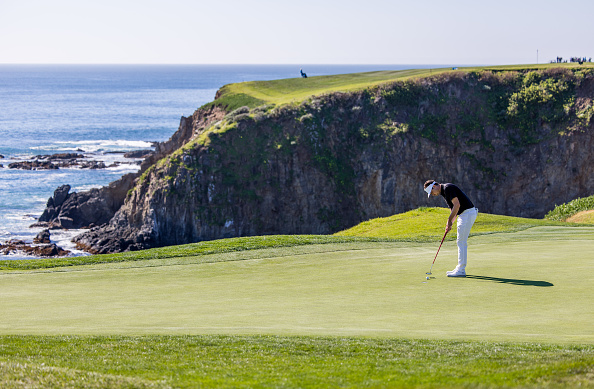Until this year’s AT&T Pebble Beach Pro-Am, the shot that resort guests at Pebble Beach Golf Links routinely inquired about most often was Tom Watson’s 17th hole chip in from the final round of the 1982 US Open. Thanks to Jordan Spieth and his harrowing, half-crazy play from the cliff’s edge at the eighth hole in early February, that’s no longer the case.
Golfers can still try to replicate Watson’s shot. But there is no recreating—not even for those who are more than half-crazy—the nervy 7-iron Spieth executed in the third round of the AT&T Pebble Beach Pro-Am.
John Sawin, vice president and director of golf at Pebble Beach, confirmed to Golf Digest on Wednesday that the area approaching the edge of the cliff over Carmel Bay has been, “pulled back.” The penalty line that Spieth’s drive crossed without tumbling over the edge and onto the rocks some 70 feet below used to be just a few feet from the precipice. Now it is six feet from the ledge, and the end of the fairway was moved back a commensurate distance. Signage that was along the edge also has been moved slightly inland and is more prominent. Finally, the rough between the end of the fairway and the bluff has been allowed to flourish.
“We wanted a ball that goes into that area to be far less appealing to play,” Sawin said. “The problem with Jordan’s shot was that he had a fairly clean lie, albeit on the edge of a cliff. He felt that he could get a club on it, whereas we want lies in there to be fairly unattractive so that people take a drop and not even be tempted to play out of there.”
Despite pleas from his caddie, Michael Greller, to take a penalty drop away from a clearly precarious position, Spieth opted to hit his second shot from a lie not more than 18 inches from the falloff. His left foot was on a downslope, and he had 162 yards to the green. He took one extra club, a 7-iron, because he planned to take an aborted pass at the ball. The shot ended up left of the green, and Spieth got up and down to save par, sinking an 18-foot putt. It was easily the most dangerous shot in terms of potential risk of bodily harm ever witnessed at a PGA Tour event.
“Looking back now, it was not smart. I wish I hadn’t done it. In fact, I regret doing it,” Spieth said that Saturday after he signed for a nine-under 63 that got him into contention. He ended up finishing second the next day to Tom Hoge.
“We’re very grateful that it ended the way it did,” Sawin said. “Some of the caddies here tell me that Jordan’s shot has now replaced the Watson chip-in among the guests as the most asked-about shot on the course. But, obviously, we want it to just be talked about from this point forward.”

Those modifications are not the only ones occurring at the eighth hole, which Jack Nicklaus called “the most dramatic par 4 in golf” long before Spieth’s nail-biting stroke. A renovation of the green currently is underway and is expected to be completed and open for use July 15. Until then, resort guests can play to an alternate green constructed in front of the original green.
The in-house work is part of an ongoing program to convert all of Pebble’s tiny greens to USGA specifications. (The average green size is 3,500 square feet, easily the smallest on the tour.) Between the 2010 and 2019 US Open championships, holes 9, 11, 13, 14 and 17 were redone.
“What we’re doing with these projects is coring-out the old greens and basically removing the sand build-up from 100 years of sand shots,” Sawin explained. “Then we’re installing sub-air and using the USGA construction specifications. And in certain instances, we’re also making subtle adjustments to slopes to restore the original design intent of the greens to accommodate today’s green speeds.”
When the work on No. 8 is completed, the green complex will look virtually the same, though the putting surface will have regained about 300 square feet, bringing the size of the green to a little more than 3,000 square feet. But the green is not being moved, stretched or reconfigured as suggested in other news reports. And then, of course, the green contours are being softened, primarily in the back left and back right portions, which will double the area for usable pin positions to about 800 square feet.
“During the 2019 US Open, all four hole locations were in the centre of the green, because nothing else on that green was pin-able at those speeds,” Sawin said. “One of our goals was to increase our options and grab more pin-able areas. But it will play nearly the same. You still don’t want to miss long. All the penal aspects of the green construction before will remain that way.”
With the US Women’s Open to be contested at Pebble Beach next year, no other work on the course is scheduled until 2024. Five greens (6, 10, 12, 16 and 18) dating from the course’s original 1919 design by Jack Neville and Douglas Grant still need to be brought up to USGA specifications. The plan calls for at least one green renovation per year from 2024-26 until the next US Open in 2027.




